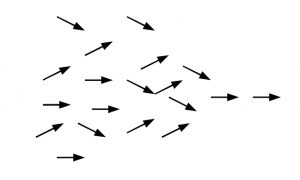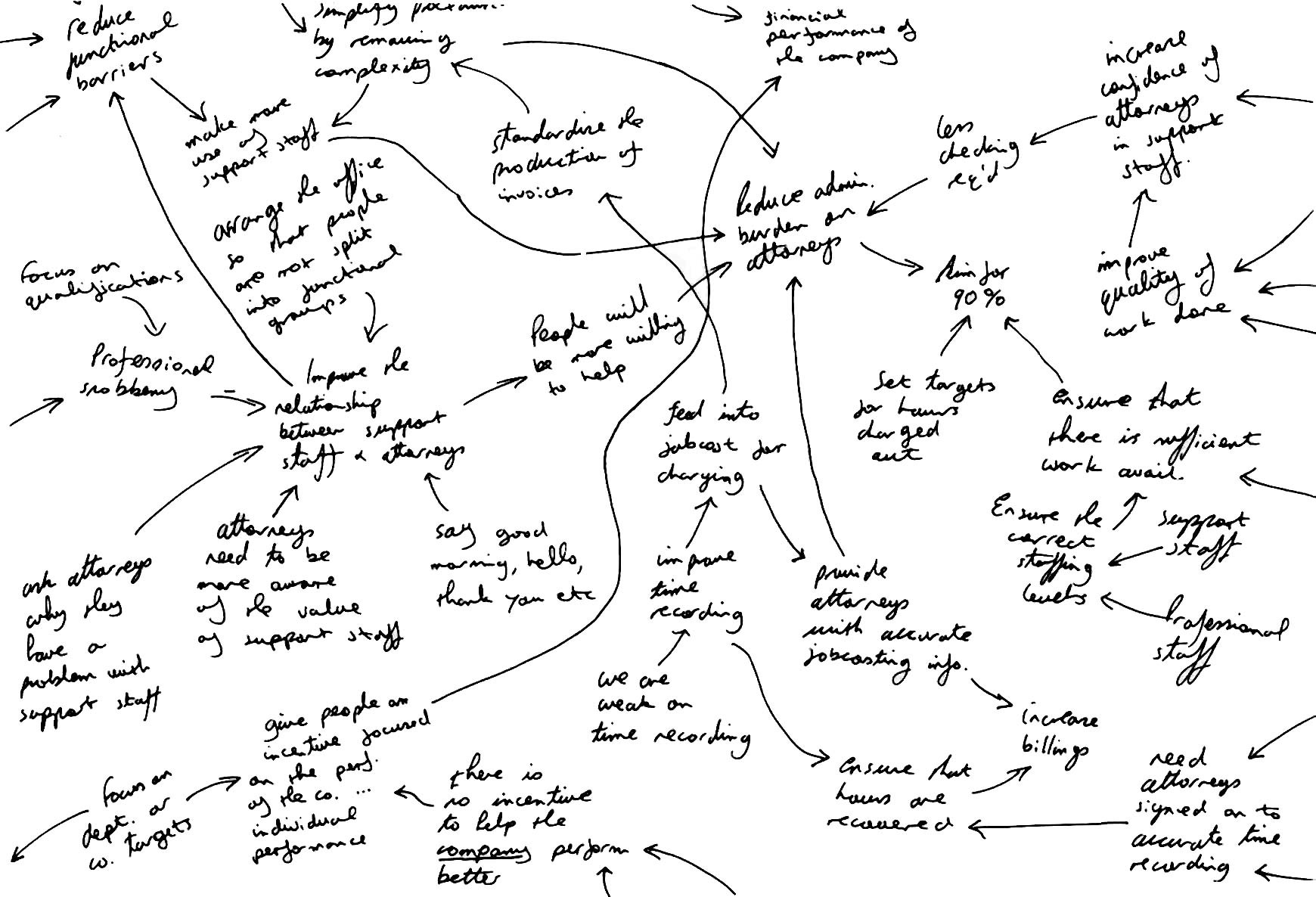Strategic Interviews Case Study
Introduction
It should be noted at this point that I took care not to use the word ‘interview’, preferring to use ‘discussion’ instead, as I felt that people would feel intimidated or, in some cases, insulted if they thought that they were being interviewed.
This was based on the premise of ‘how do I know what I think until I hear what I say?’, which suggests that the act of discussing an issue can help the participant to take ownership of it, thereby helping to start the process of consensus building.
Interview Schedule
The interviews had been scheduled to take account of ‘political weighting’, in other words, the most senior people were interviewed first. The reason for this was to ensure that the key issues raised by senior management were fed into the subsequent interviews, thereby ensuring that the final group model would, to some extent, be moulded around their thoughts.
I found that the interviewees were inclined to stay within their own functional boundaries and tended to resist attempts to persuade them to talk about more general issues about the business. One interviewee actually said that he was deliberately dealing with issues that related to his department. I think that this may have been due to the functionally focused nature of the organisation meant that they were very knowledgeable about their own area of the business but because they had not been exposed to the wider business issues, they had a very narrow view of the business. Subsequent analysis of the group model tends to support this since the need to gain a better understanding of what others do was raised as an issue in terms of improving internal co-operation and communication. This is indicative of lack of knowledge about the business in general within the group that was interviewed.
The Interviews
A series of eight interviews were held with the senior and professional staff in the company. These discussions centered on exploring the ways in which the business ought to develop over the next few years. Each participant’s comments were recorded as a series of statements, connected by arrows representing a cause and effect relationship, effectively creating a map of their thoughts, as shown in Figure 1.
Figure 1 – Example of an extract of a causal map
The interviews were held in a relatively neutral location, away from the interviewee’s office. This helped to reduce the possibility of interruption and, perhaps more importantly, to move them out of their own environment, or ‘comfort zone’. Using a neutral location also aided facilitation, as I was able to set the room up in advance, making it as ‘user friendly’ as possible.
Research has shown that a relationship exists between the nature of interaction between people and their position around a table. They found that an angle of 90 degrees is the preferred position for conversation. In order to help to build a degree of mutual confidence and also to ensure that they could see what I was writing, I arranged the chairs so that I was sitting at a 90 degree angle to the interviewee, as shown in Figure 2.

Figure 2 – Example of seating position when conducting a strategic interview
This worked very well with the exception of one interviewee, who took the seat directly opposite me when I made an attempt to take the seat to his left. This suggests that he was adopting a defensive position which was not conducive to a productive discussion. I switched my position, explaining that it was important that he could see what I was doing.
He continued to adopt a defensive position throughout most of the interview, sitting back in this chair, often with his arms folded, and making no attempt to look at what I was writing, despite my attempts to encourage him.
I had had some concerns about this person before the interview as I felt that he was not interested in the process and it was clear from his non-verbal signals that he was simply ‘going through the motions’. As an facilitator, it is important in these circumstances not to take people’s negative reactions personally and to remain calm and positive throughout.
This highlights the importance of not only performing a stakeholder analysis within the organisation, but also taking care to act on the information that is obtained. Whilst I had identified this person as being a potential saboteur of the process, I had underestimated the level of his negativity. With hindsight, it may have been beneficial to engage them in the process at an earlier stage by, for example, asking their opinions on various aspects of the design of the intervention.
The interviews were intended to elicit the emergent goals of the actors involved, with objectives being surfaced using a technique that called ‘Laddering’. This involves encouraging the interviewee to elaborate on the issues that they raise by asking ‘so what?’ type questions. This helps to generate causal relationships in a way that uncovers information about their aspirations.
This proved to be very difficult for two reasons. Firstly, I believe that the problems with the MBO may have affected the state of mind of the interviewees, causing them to focus on the short-term rather than looking too far forward. This could have signalled that they saw only a short-term future for the company and/or for themselves within it. The fact that there was probably some anger and bad feeling would also have affected their views.
Secondly, I found that they consistently started the interview with topics that were at the forefront of their minds and that these issues were normally operational in nature. One interview in particular provided a good example of this. The interviewee spent about 10 minutes discussing issues relating to something that had happened a few hours earlier and when he finished, he said that he did not know why he had talked about it because he did not think that it was that important!
I think that there is a danger with this methodology in that people can focus on current issues at the expense of looking past that into the future. It is, therefore, important that the facilitator is aware of this and is able to direct the conversation in the appropriate way. This is, however, not as easy as it may seem as I found that the interviewee can very often be determined to get ‘today’s special’ off their chests and they tend to resist attempts to steer the direction of the conversation away from it. I found that it is best to let them get whatever is bothering them out of their system and then to move the interview forward from there. This worked well in all but one interview where the interviewee seemed to want to take up the whole discussion with anecdotal ramblings and it proved to be very difficult to get him to focus on the issues at hand.
I believe that I would have obtained far better results if the participants had been given some information relating to the subject matter before the discussion. This would have given them time to think about the issues and may, therefore, have generated a greater depth and quality of information. This is supported by the fact that I found that people tended to arrive with some preconceived ideas of what they were going to discuss and had done some preparatory work in advance of the interview, despite being asked not to. One participant even arrived with his laptop computer and used it during the initial stages of the interview to refer to notes that he had made on it before the meeting! I believe, therefore, that if people are going to prepare anyway then it would make sense to give them the information that will allow them to think about relevant issues.
As discussed, it is important to try to uncover the goals and aspirations of the participants. One technique that is favoured by many is what is known as the ‘Oracle Question’. Here, the interviewee is asked to consider what questions they would ask someone who is able to foretell the future. I tried this in one interview and I was amazed by the reaction of the individual concerned – the transformation in his demeanour was almost miraculous. After thinking about it for a few seconds, his manner changed completely; he leaned forward and his eyes came alive as he began to describe his vision for the future. It is clear that this technique has significant potential as a tool for eliciting emergent goals and I would recommend its use in this type of environment.
In general, I found that the interviewees were more than happy to talk, to the extent that the amount of information that was forthcoming was often difficult to manage. While I was able to record what was being said, I had some difficulty finding the opportunity to discuss the linkages between the statements with the interviewee. While many of the links tended to follow the flow of the conversation, I found that I often simply drew lines between concepts in an attempt to keep up with what the interviewee was saying. This meant that I had to return to them later to discuss the cause and effect relationships. It is important to find a balance between asking for clarification and trying to avoid breaking the interviewee’s train of though.
Conclusions
An analysis of the individual maps confirmed that no two individuals think alike. A wide variety of opinions were generated, with each person contributing an average of 100 concepts, less than 14% of which were duplicated by others. An average of 7 key issues were raised by individuals and most were well articulated.
As one might expect, an analysis of the group model, which was created by merging the individual maps, showed a far higher degree of articulation of the key issues with an average of 4 people contributing an average of 11 statements to each of the key issues that were surfaced. This indicates that some commonality of thinking exists within the group and I would, therefore, conclude that there is a basis on which a consensus view of the strategic future of the company could be built.
This process helped me to understand the concept of a ‘consensus strategy’ as shown in Figure 3. I had originally thought that the arrows in the diagram represented differences of opinion on the same or similar topics. Based on the work that I have done, I believe that they represent the different perspectives that people hold about the future and about the issues that face the organisation. To me, these perspectives do not represent the potential for conflict but rather the richness and diversity opinion that exists within the organisation.
 Figure 3 A representation of how people’s perspectives gradually change as a consensus is formed.
Figure 3 A representation of how people’s perspectives gradually change as a consensus is formed.
This is supported by the fact that even though a large number of issues were surfaced, none of them was contradictory in nature. Consequently, consensus is reached by allowing people to gain an insight into the views of others, which they may not have considered before, and to build a joint understanding on that basis.
It should, however, be noted at this point that the group with whom I was working had been involved in a large number of meetings relating to the MBO. It is possible that those meetings may have inadvertently started the process of negotiating consensus, through allowing the people involved to gain an insight into the opinions of others. This may then have meant that they consciously, or subconsciously, avoided topics that they believed would be controversial or would cause conflict.
In general, I found the interview process to be a very valuable tool and one that is suited for use in a company where the culture is not conducive to team working. The fact that it allows individuals involved to have much more ‘air time’ than they would have in a group situation means that it is also useful in situations where a greater depth of information is required. It should, however, be noted that it places a significant time burden on the facilitator and also generates a great deal of material which can make the analysis of the aggregated group model challenging.

